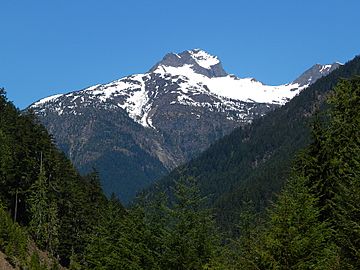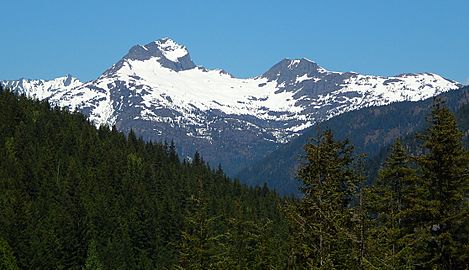Crater Mountain facts for kids
Quick facts for kids Crater Mountain |
|
|---|---|

Crater Mountain seen from North Cascades Highway
|
|
| Highest point | |
| Elevation | 8,132 ft (2,479 m) NAVD 88 |
| Prominence | 1,928 ft (588 m) |
| Isolation | 2.86 mi (4.60 km) |
| Parent peak | Jack Mountain (9,066 ft) |
| Geography | |
| Location | Whatcom County, Washington, U.S. |
| Parent range | North Cascades |
| Topo map | USGS Crater Mountain |
Crater Mountain is a tall mountain in the North Cascades of Washington state. It stands about 8,132-foot (2,479-metre) high. This makes it one of the highest mountains in the Pasayten Wilderness.
Even though its name sounds like it, Crater Mountain is not a volcano. Its summit looks like a crater because of how glaciers shaped it. A glacier called the Jerry Glacier sits on the upper north side of the mountain. Crater Mountain is part of a group of mountains called the Hozameen Range. This range also includes Hozomeen Mountain and Jack Mountain.
Contents
What is Crater Mountain Made Of?
Crater Mountain is mostly made of special kinds of rocks. These rocks are called metavolcanic and metasedimentary rocks. They come from a group of rocks known as the Hozameen Group.
Greenstone Rocks
The most common rock here is called Greenstone. This rock formed a very long time ago, between the Jurassic and Permian periods. Imagine, this greenstone was once the bottom of an ancient ocean called the Methow Ocean!
How the "Crater" Formed
The mountain's name comes from the way its top looks like a crater. But this shape was not made by a volcano. Instead, powerful glaciers carved out the ancient greenstone, giving it its unique look. Below the rugged greenstone, you can also find a rock called phyllite on the lower parts of the mountain.
Weather at Crater Mountain
Crater Mountain is in a place with a "marine west coast" climate. This means it's near the Pacific Ocean, which affects its weather a lot.
How Weather Forms
Most of the weather here starts over the Pacific Ocean. It then moves east towards the Cascade Mountains. When the air hits the tall mountains, it's forced to rise. As it goes up, it cools down and drops its moisture. This causes a lot of rain or snowfall on the west side of the North Cascades.
Temperatures and Snow
Because it's close to the ocean, the temperatures here are usually mild. It rarely gets colder than 0 °F (−18 °C) or hotter than 80 °F (27 °C). In winter, it's often cloudy and snowy. But in summer, high pressure systems over the ocean bring clear skies. The snow here tends to be wet and heavy. This can sometimes lead to a high risk of avalanches.
Best Time to Visit
If you want to see or climb Crater Mountain, the best time to go is usually from July through September. The weather is most pleasant during these months.
Gallery
Images for kids







